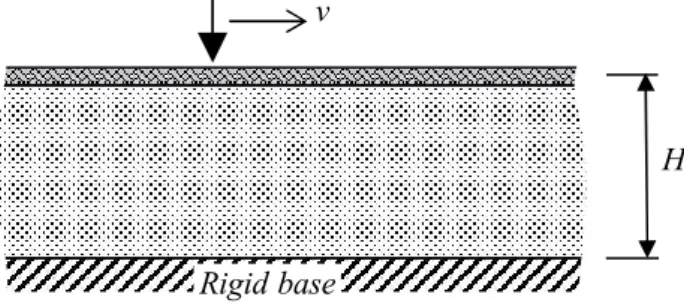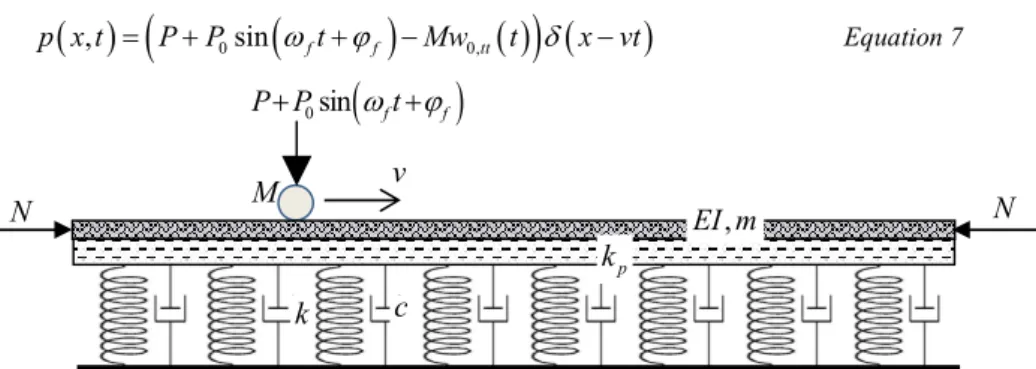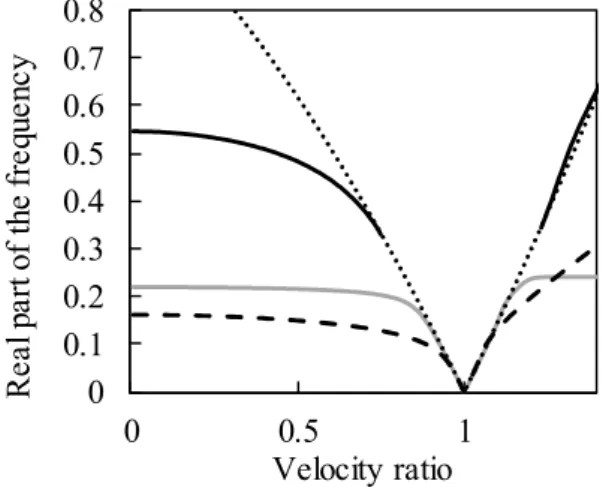12th World Congress on Engineering Asset Management &
13th International Conference on Vibration Engineering and Technology of Machinery 2-4 August 2017, Brisbane, Australia
Semi-Analytical Approach to Vibrations
Induced by Oscillator Moving on a Beam
Supported by a Finite Depth Foundation
Zuzana Dimitrovová 1Abstract Structures subjected to moving loads have several applications in rail, road and bridge engineering. When the velocity of the moving system approaches the critical velocity, then the induced vibrations are significantly augmented and safety and stability of the structure as well as of the moving system are compro-mised. The classical models predict the critical velocity much higher than the one observed in reality, because the wave propagation is restricted to the beam struc-ture. But if the beam is supported by elastic continuum, then the waves can be dominant in the foundation and the interaction with the beam cannot be over-looked. This contribution analyses the critical velocity of an oscillator moving on a beam supported by a foundation of finite depth by semi-analytical methods.
1 Introduction
The objective of this contribution is to fill the gap in semi-analytical solutions related to wave propagation induced by moving loads. An analysis of the critical velocity of an oscillator moving on a beam supported by a foundation of finite depth is presented. Such analysis is important for transport engineering, as struc-tures subjected to moving loads have several applications in rail, road and bridge engineering. The classical model where the beam structure is supported by mass-less linear springs is still used by several companies, due to its simplicity. Never-theless, in this model the wave propagation is restricted to the beam structure and no dynamic interaction with the foundation can be accessed. Models considering beams placed on elastic continua of finite depth provide better access to the inter-action mechanism. Nevertheless, as the inertial effects are important in the sup-porting structure, they are also important is the moving system. This means that
1 Z. Dimitrovová ()
Departamento de Engenharia Civil, Faculdade de Ciências e Tecnologia, Universidade Nova de Lisboa and IDMEC, Instituto Superior Técnico, Universidade de Lisboa, Lisboa, Portugal e-mail: zdim@fct.unl.pt
to Vibrations Induced by Oscillator Moving on a Beam Supported by a Finite Depth Foundation
the moving system should not be approximated by moving forces, as it is com-monly done, but at least by a moving oscillator.
There are already several works dedicated to analytical and semi-analytical so-lutions, mainly concerned with stability issues of the moving oscillator, (Metrikine and Popp, 1999), (Metrikine et al., 2005). In this paper different approach is pre-sented directly linked to the issue of the critical velocity. At first, the problem of a moving force travelling over a beam supported by a finite depth elastic continuum in two-dimensions will be reviewed. Then, the semi-analytical solution of the mass moving on a beam supported by elastic springs will be extended to moving oscillator and validated by software LS-DYNA. Finally, the foundation will be substituted by frequency dependent springs, which is an acceptable approximation of the elastic finite depth continuum, and conclusions on the critical velocity will be drawn.
2 Finite Depth Elastic Continuum
It is assumed that the load P is traversing an infinite beam supported by a foun-dation of finite depth H, by a constant velocity v, as depicted on Figure 1. It is fur-ther assumed that: (i) the beam obeys linear elastic Euler-Bernoulli theory; (ii) the foundation is represented by a linear elastic homogeneous continuum of finite width b under plane strain condition; (iii) the beam may be subjected to a normal force N acting on its axis (considered positive when inducing compression); (iv) gravitational effects on the beam and on the foundation are neglected.
Figure 1 Infinite beam on an elastic foundation of finite depth subjected to a moving load
It was derived in (Dimitrovová, 2016) that if horizontal displacements are omit-ted, but shear deformations are accounted for in the vertical dynamic equilibrium of the foundation, then the critical velocity ratio cr defined as cr Vcr/vcr, where Vcr is the new value of the critical velocity and vcr is the classical value of
P
v
H
Beam Supported by a Finite Depth Foundation 3
the critical velocity of the load passing a beam on Winkler’s foundation, is gov-erned by an approximate formula
2 2 1 2 s cr N s s M Equation 1where, s is the shear ratio defined as s v vs / cr with vs being the shear-wave velocity, and M is the mass ratio defined as the square root of the foundation mass to the beam mass M bH m/ with
being the soil density and m the mass per length of the beam. Thus, for a lower mass ratio, the critical velocity ap-proaches the classical value vcr N, with the effect of the normal force specified by the ratio N; and for a higher mass ratio, it approaches the velocity of propagation of shear waves in the foundation, which is the lowest wave-velocity of propaga-tion related to the model adopted, because the Rayleigh waves cannot be devel-oped if horizontal displacements are not properly introduced.In the full two-dimensional model, both dynamic equilibrium equations are considered and thus horizontal displacements are not omitted. The system of gov-erning equations read
,tt
u
u
u Equation 2
,xxxx ,xx b ,t ,tt f
EIw Nw c w mw p P x vt
Equation 3where u
u ux, z
is the vector of the displacement field in the foundation,
and
are Lame´s constants of the elastic continuum, EI and c stand for the b bending stiffness and the coefficient of viscous damping of the beam, p is the f foundation pressure and t is the time. Overall this paper, derivatives will be desig-nated by the corresponding variable symbol in the subscript position, preceded by a comma. Moreover, is the gradient and is the Laplace operators applied on spatial variables x, z. The unknown beam deflection w x t
, , displacement uz, spatial coordinate z and force P are assumed positive when acting downward. Spa-tial coordinate x is positive to the right, the load travels from the left to the right and finally, is the Dirac delta function.The solution method exploits displacement potentials and moving coordinate. Then, for the steady-state solution time dependent terms can be neglected and af-ter the Fourier transform, analytical solution can be obtained in the Fourier space. The additional interface condition is ambiguous and can be written in form of zero
to Vibrations Induced by Oscillator Moving on a Beam Supported by a Finite Depth Foundation
horizontal displacement (ZHD), zero shear stress (ZSS) or some combination of these two in form of horizontal interface spring. The critical velocity can be identi-fied in a semi-analytical way by identification of double poles on the real axis of the Fourier variable of the beam displacement image. Approximate formula for the critical velocity ratio is given as a sum of two parts, one is an addition to the pre-vious Eq. 1 and the other one is an adaption Eq. 1
, 1 2 2 2 2 2 2 j 2 j N cr add j a j N a M a a M Equation 4
, 3 2 3 2 1 2 j cr prev N a j a j M Equation 5where aN 2a N
j N
2 with a1 or 10 when j N. In addition the sub-script j is related to the velocity of propagation of shear waves, thus j=s, a10.3,2 0.4
a , a30.99 for ZHD; and for ZSS it is related to the velocity of propaga-tion of Rayleigh waves, thus j=R, a10.5, a20.4 and a30.98, so
/
R v vR cr
, where vR is the velocity of propagation of Rayleigh waves. Results of the critical velocity are slightly affected by this additional interface condition, as can be seen in Figure 2.Figure 2 Critical velocity ratio: simplified model (dotted), ZHD condition (dashed), ZSS condition (full), s1.1 0.8 0.85 0.9 0.95 1 1.05 1.1 1.15 0 2 4 6 8 10 C rit ic al v el oc ity r at io Mass ratio
Beam Supported by a Finite Depth Foundation 5
In Figure 3 the influence of the normal force is shown for
N 0.5, simplified approach and ZSS condition are placed together in one graph for
s 1.0;1.5 .Figure 3 Critical velocity ratio: simplified model (dashed), ZSS condition (full grey), 1.0;1.5
s
, for each case the curves are starting from the bottom
It is seen, that there are some differences between the results of the critical ve-locity ratio related to ZHD and ZSS reflected especially in the asymptotic value of the critical velocity, which is vs and vR for the two conditions, respectively. On the other hand the asymptotic value of the simplified model and ZHD is approxi-mately the same.
3 Massless Springs
In order to extend the previous analysis to the moving oscillator, finite beams on elastic springs foundation will be considered first. The reason is that, as shown in (Dimitrovová, 2017), the results on long finite beams provide very good ap-proximation to the results related to infinite ones, so long as the mass is added to the moving force. Then the semi-analytical technique for solution of the moving mass problem by eigenvalues expansion can be extended to the moving oscillator and finally to the frequency dependent foundation. Last step would be to consider the complete two-dimensional continuum.
0.4 0.6 0.8 1 1.2 1.4 0 1 2 3 4 5 6 7 8 9 10 C ri ti ca l ve lo ci ty r at io M ass ratio
to Vibrations Induced by Oscillator Moving on a Beam Supported by a Finite Depth Foundation
Thus, let a uniform motion of a constant mass and a vertical force with harmon-ic component along a horizontal infinite beam posted on a two-parameter visco-elastic foundation be assumed. Besides the previous simplifying assumptions, it is assumed that the mass is always in contact with the beam and its horizontal posi-tion is determined by its velocity. The problem at hand is depicted in Figure 4.
The equation of motion for the unknown vertical displacement read
,xxxx p ,xx ,tt b ,t ,
EIw N k w mw c w kw p x t Equation 6
with the loading term being
,
0sin
f f
0,tt
p x t P P t Mw t x vt Equation 7
Figure 4 Finite beam on a visco-elastic two-parameter foundation subjected to a moving load and a normal force
Because this analysis will be used only for representation of the infinite situa-tion, boundary conditions can be selected in the most convenient way. Assuming that only n modes will be used, a compact matrix form for the generalized coordi-nate calculation can be presented as
t ,tt
t
t ,t
t
t t
tM q C q K q p Equation 8
where square nxn matrices M , C, K are not approximations resulting from some discretization of the problem, but are defined by vibration modes in their ex-act analytical form
jk jk j k M Mw vt w vt Equation 9
,
2 jk jk j k x c C Mvw vt w vt m Equation 10
0sin f f P P t v k M N N c , EI m p kBeam Supported by a Finite Depth Foundation 7
2 2 , jk jk j j k xx K Mv w vt w vt Equation 11
0sin
j f f j p P P t w vt Equation 12These terms can be reordered, keeping the diagonal part of the matrices and intro-ducing an additional variable
that will join the necessary terms
1 D jk j k M w vt t Mw vt M ,
, 0 2 0 D jk k x C t Mvw vt C Equation 13
2
, 0 0 D jk k xx K t Mv w vt K Equation 14Thus there is only one coupled equation and the second time derivative of the ad-ditional variable equals the contact force. If the oscillator is added, then the load-ing term from Eq. 7 must be completed by
k w tos 0 k w tos os
x vt
Equation 15and additional equation read
, 0
os os tt os os os os
M w t k w t k w t P Equation 16
where the subscript “os” designates the quantities related to the oscillator. For typ-ical values related to railways applications and very soft foundation, it is seen that mass induced frequency is superposed with the oscillator frequency (Figure 5).
to Vibrations Induced by Oscillator Moving on a Beam Supported by a Finite Depth Foundation
Therefore, the method for the critical velocity determination follows the identifi-cation of the resonant case. The mass induced vibration can be determined by semi-analytical methods presented in (Dimitrovová, 2017). The typical graph of the real part of the induced frequency is shown in Figure 6.
Then according to the natural frequency of the oscillator, the velocity of the mov-ing system is determined.
Figure 6 Real part of the dimensionless mass induced frequencies: two-mass oscillator (black and grey), moving mass (dashed) and cutting frequency (dotted)
4 Conclusions
In this paper a technique for semi-analytical determination of the critical velocity of the moving oscillator is proposed. Based on the characteristics of the oscillator, such a critical velocity can be lower that the critical velocity of the moving force and also lower than the velocity inducing instability of the moving mass.
Acknowledgements
This work was supported by FCT, through IDMEC, under LAETA, project UID/EMS/50022/2013.
References
Z. Dimitrovová, Critical velocity of a uniformly moving load on a beam sup-ported by a finite depth foundation. J Sound Vib, 366, 325–342, 2016.
0
0.1
0.2
0.3
0.4
0.5
0.6
0.7
0.8
0
0.5
1
R
ea
l p
ar
t o
f
th
e
fr
eq
ue
nc
y
Velocity ratio
Beam Supported by a Finite Depth Foundation 9
Z. Dimitrovová, New semi-analytical solution for a uniformly moving mass on a beam on a two-parameter visco-elastic foundation. Int J Mech Sci, 2017 (press).
A.V. Metrikine, K. Popp, Instability of vibrations of an oscillator moving along a beam on an elastic half-space, Eur J Mech A-Solid, 18, 331-349, 1999.
A.V. Metrikine, S.N. Verichev, J. Blaauwendraad, Stability of a two-mass os-cillator moving on a beam supported by a visco-elastic half-space. Int J Solids Struct, 42, 1187–1207, 2005.




